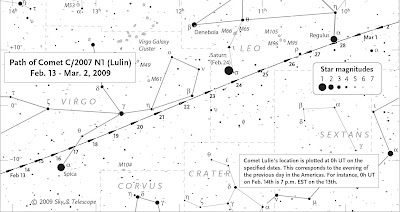 The path of Ceres through Leo in the North Eastern Sky
The path of Ceres through Leo in the North Eastern SkyThis Weeks Scilly Stars.
We have an adrenaline drenched week this week, with a comet on fly by, our largest asteroid only 60 million miles away, Neptune’ s on the way back, and there’s an important anniversary, not the big one but the big ones granddad.Comet Lulin this week is at its brightest and closest to Earth — right when the sky is conveniently moonless. Use binoculars or a telescope to look for it once it's well up in late evening. The comet is glowing at about magnitude 5.6 as it moves rapidly westward across Virgo just skirting Leo, and very close to Saturn all week, in the North East around 9pm. In recent days the comet's dust-spike has grown longer and stronger, completely outclassing its "true" tail, which points properly away from the Sun like a comet's tail should. It’s dim but easily visible with binoculars and both tails should show. It will be visible for most of the night, look at the blog for a find it guide.
And sticking with Leo, Ceres the largest of the Asteroids is at the closest and best viewing position of our lifetimes and a lot of subsequent lifetimes for that matter. Ceres will pass closer to Earth than it has been since 1857, it won’t be this close again until 4164, an occasion I may well miss. You can spot it with binoculars, which are essential, in Leo, again close to Saturn using the chart at on the blog.
And Friday is a red letter day for Uranus when its as far as it gets from the Sun as it can in its 84-year orbit. So we can all take comfort knowing that no matter how bad things get, for the rest of our lives, Uranus will be just a touch closer every day.
Of the planets Venus and Saturn are the only two really showing at the moment. Jupiter, Mercury, and Mars remain very low in the glow of sunrise, where they're changing configuration daily. Mars is very faint and may require binoculars. But Venus is still dominating the western sky until 9pm, someone asked my mum to ask me what the very bright star above Star Castle perhaps pre-empting the second coming is, well it’s Venus, which I may have mentioned previously on Scilly Stars.
The planet sets about 9pm and if you want to catch it and Saturn together find Venus around 8:30, turn 180 degrees and almost diametrically opposite you will see the yellowish glow of Saturn, in the same area of the sky where you will also find Ceres and Comet Lulin.
March the 3rd is the 40th anniversary of Apollo 9, which was the third manned mission of the Apollo Program, and proved the Lunar Module worthy of manned spaceflight. Further tests on Apollo 10 would prepare the Lunar Module for its ultimate goal, landing on the Moon.
That was you nights sky for the week ending next Tuesday.














